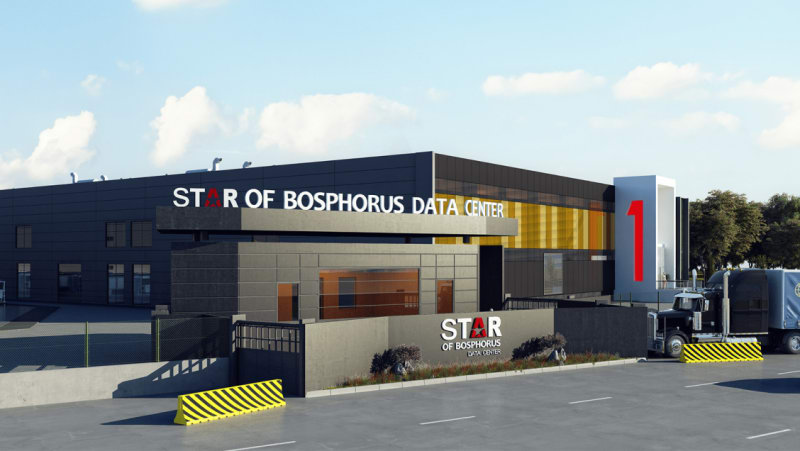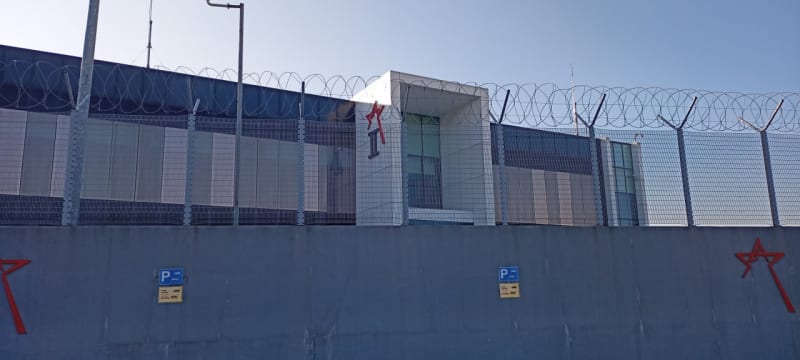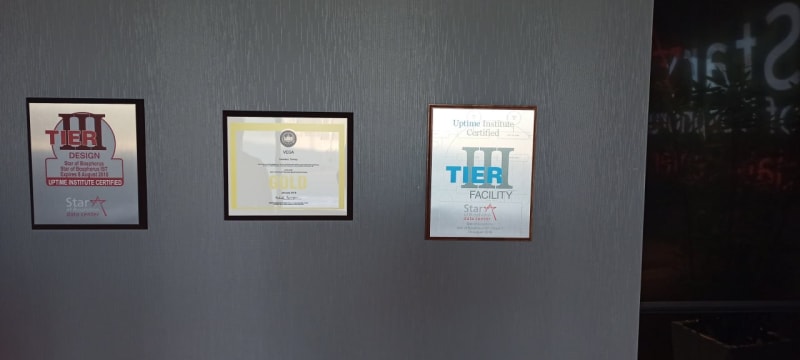Recently, our specialists installed and connected equipment in a modern data center in Turkey. The new location is now available in the control panel, and there is an option to create virtual machines in Istanbul. The Star of Bosphorus data center occupies a vast area of 45,000 square meters and holds Uptime Institute Tier III Design & Resort certification.
In the following sections, we’ll discuss what attracted us to this data center and why we chose it, the features of this data center, the server equipment we installed in the cluster, how we connected the equipment, and we’ll present the network diagram.
Star of Bosphorus
The “Star of Bosphorus” was chosen by our team for several reasons. Firstly, it is a state-of-the-art data processing center and the first earthquake-resistant data center in Turkey, which has passed the Uptime Institute Tier III Design & Resort certification. It belongs to one of the leading IT companies in Turkey — NGN.
Secondly, it is a large, secure facility of 45,000 square meters, located away from the city, in the industrial part of the Tuzla district in Istanbul. It provides backup access, an uninterrupted power supply, and is free from many physical risks, as it is located near the Istanbul power distribution station (Tepeören Electricity Distribution Plant).
Data Center Construction
**What makes the “Star of Bosphorus” safe? **The data center has a scalable structure with four data processing center modules (Data Center Modules — DCM) in two separate buildings. Each module has its infrastructure with power, cooling, fire protection, and physical security systems.
And what about seismic stability? The data center is located on safe ground, free from erosion risk, and away from dams or large water reservoirs. The data center was built using seismic isolation construction technology and designed considering the geographic specifics, i.e., frequent earthquakes characteristic of the region. It is claimed to be resistant to earthquakes of 9+ magnitude (though we have not verified this) thanks to the 138 installed movable seismic isolators.
Power
The data center has a total electrical power of 16 MW. This is sufficient to power large volumes of data and high-load systems. The data center is equipped with an uninterruptible power supply system, based on a 2N redundancy scheme. There are two independent power supply lines, fully backing up each other.
The data center is also equipped with backup diesel generators. They automatically switch on when a main power interruption is detected, providing electricity for the continuous operation of the equipment. In case of external power failure, the fuel supply will last at least 72 hours.
The Star of Bosphorus ensures energy saving and optimization of carbon dioxide emissions by using 10% less active cooling and also battery-less Diesel Rotary Uninterruptible Power Supply systems (DRUPS).
Cooling
The Star of Bosphorus is equipped with an air conditioning system with an N+1 redundancy level. The system has a backup air conditioning module capable of providing the necessary cooling even in case one of the modules fails.
To maintain optimal temperatures inside the data center in case of main power supply interruption, there are backup generators. They provide electricity for the cooling systems to prevent overheating of servers and equipment.
Security
In the Star of Bosphorus, not only 24/7 security is implemented to ensure safety, but also a four-tier access control system. It includes a retina scanner, X-ray, and mantrap.
A mantrap is a tight space made of thick glass with two doors, operating on a trap principle. The door through which a person enters is locked, and the door to enter the data center opens only if the visitor passes a security check within a limited time. So if you hesitate, the doors will lock and you will be released only after the arrival of a security service. It’s quite a stressful event, but it is another guarantee of infrastructure safety.
Comprehensive security features include:
- 24/7 security;
- 4-tier physical security system on the data center territory (X-ray, second X-ray, mantrap, retina scan);
- 24/7 video surveillance in the building and data halls;
- 24/7 data center infrastructure monitoring with a camera, supported by digital records with PCI-DSS related controls;
- smart card readers with biometric access authentication technology;
- secure cabinets and cages;
- visitor identification and authorization.
Our employees who have been there confirm the high level of data center protection. The data center resembles a small fortress. It has several checkpoints, inability to get into the data center without local accompaniment, or to leave the server room without an security and to enter back.
Fire Protection
The Star of Bosphorus fire protection is based on fire detection and suppression systems, including smoke detectors, automatic fire suppression systems, and area partitioning to prevent fire spread.
An automatic NOVEC 1230 (FK-5–1–12) gas fire suppression system is installed here, along with 2000 fire sensors. It represents an environmentally friendly alternative to traditional water or gas-based fire suppression systems.
The system quickly responds to fire detection and suppresses the fire by creating a mix of steam and gas at the fire source, which helps to stop the fire spread and prevents its reignition. Its solvent is a fluorinated ketone that has low toxicity and does not harm the environment. It is compatible with electronic devices, does not conduct electricity, and does not damage them.
Certifications
Let’s list the main standards and certifications that the data center has:
- SOC 1
- LEED
- ISO 9001:2008
- ISO 27001:2013
- ISO 9001–2011
- PCI DSS
- Tier III Design and Facility
Tier III Certification
A Tier III data center is typically equipped with an infrastructure that has a high level of redundancy. It supports maintenance and replacement of equipment without stopping the entire facility. All elements have several backups: there are multiple power and cooling supply channels. During maintenance periods (8–12 hours), only one of these elements is active. Tier III certification is only granted if the data center’s construction and performance meet the standard’s criteria under real conditions.
We already have data centers that have Tier III certification, as well as locations built to Tier III standards. A new data center that meets this certification — Star of Bosphorus in Turkey — has now been connected. There are few providers in the country whose facilities meet this standard. Many of them have a Design class certificate, which only shows compliance in terms of design documentation. Star of Bosphorus has two of the three possible classes of certification:
Tier III Design Documentation Uptime Institute. This certificate attests that the data center infrastructure, as presented in the design documentation, meets the requirements of Tier III Uptime Institute certification.
Tier III Constructed Facility Uptime Institute. This certificate confirms the ability to carry out any regulatory and repair work without affecting the IT load, thereby ensuring the reliability and continuity of customer business processes.’
LEED
LEED (Leadership in Energy and Environmental Design) is a new certification for our data centers not mentioned in the article. It is an international certification that confirms the use of efficient and environmentally friendly design and construction methods. This system was developed by the US Green Building Council (USGBC).
LEED is a widely accepted rating system that assesses buildings in terms of design, construction, and ongoing operations. LEED-certified buildings, which have lower operating costs, reduce energy and water expenses by up to 40%.
Star of Bosphorus is equipped with mechanical systems necessary for protecting nature and the environment, ensuring energy saving and optimizing carbon dioxide emissions by using 10% less active cooling. It also carries out environmentally safe operations thanks to battery-free Diesel Rotary Uninterruptible Power Supply (DRUPS).
Equipment and Connection
The data center has deployed eight vStack-R 2U servers, one of which is kept in reserve. This reserve, or test server, is necessary for testing any planned configuration changes — firmware and settings.
Currently, the data center operates seven vStack SL201-D25RE servers with the following configuration:
- 2x CPU: Intel® Xeon® Gold 6226 CPU @ 2.70GHz
- 16x RAM: 64Gb RDIMM 3200MHz
- 14x SSD Intel S4610, 960GB SSD SATA
- 1x NIC Mellanox, MCX512A-ACAT 25GbE
- 1x NIC Intel G82599L 10GbE
- 1x HBA Controller Broadcom 9400–16i SGL
Mounting
Each installation brings us new experiences. For example, in Canada, where we launched a cluster last year, the mounting process was managed by “remote hands.” However, in Turkey, a different approach was used. The specifics of the data center, as well as the intricacies of installing new equipment, led to the decision for our specialists to perform the installation on-site.
Before the installation and the arrival of our mounting team, all communication with the data center took place through our company’s representative in Turkey, who speaks the local language. Instead of a console, like in Cologix for example, NGN uses phone calls with the contractor or email communication, so having a “native speaker” was essential. This specialist also served as a guide and “pass” into the data center — it would be impossible to get in without him.
The equipment was installed and mounted within two days. After delivery, our specialists prepared two racks for installation and performed on-site server inspection and assembly. They then mounted the equipment on the rails and prepared it for network connection. The fiber optic and twisted pair connections were also switched to ensure data transmission. To allow our Network team to start the setup and connection process, we initialized the server equipment through console access.
After this, the task of setting up the network part was handed over to the Network team, so they could arrange the technical connection. This included setting network parameters, ensuring reliable connection, and verifying the functionality of the entire network infrastructure.
Network Connectivity Setup
Let’s move on to the Network team. The diagram above presents the fundamental network layout of our location in the Turkish data center. On the Cisco ASR 9001 routers, a BGP interface with two providers is organized (with automatic route changes when one of the channels fails). BGP — Border Gateway Protocol — is the protocol on which the Internet is essentially built. It ensures the operation of the Internet by exchanging routing information. The ASRs are also interconnected via the BGP protocol and are further connected to the Cisco Nexus 93360 switches. The ASR routers handle external traffic, while the Nexus switches manage the “inner world.”
The switches are interconnected using a vPC peer link. vPC technology allows for the combination of two physical devices into one virtual one. One of the switches plays the role of vPC-primary, and the other is vPC-secondary. The roles of primary and secondary affect the behavior of the switches in case one of them fails. All other equipment is connected to the switches.
To verify the effectiveness of the scheme, stress testing was conducted to see how the system handles extreme loads. It allows us to assess how the cluster responds to failures and ensures continuous operation. The entire network infrastructure, including ports and nodes, is backed up. In the first part of the testing, one of the two switches was turned off to check how the cluster reacts and continues to operate. It worked without any problems, demonstrating the reliability of the system. Then the second switch was disconnected, and its performance was tested.
In the second part of the testing, the system was made unstable. We simulated a node loss and tested the cluster’s resilience with the sequential loss and return of each node. The system components proved to be fault-tolerant, including the network, server part, and data storage.
What does this give you?
You can quickly deploy a virtual server in the new location — Turkey (Istanbul) — through the Serverspace control panel. Creating a virtual machine is available with the following configurations:
Supported OS:
- Linux (OEL/CentOS/Ubuntu/Debian);
- FreeBSD;
- Windows Server.
Resources per server:
- Up to 16 CPUs;
- Up to 128 GB RAM;
- Up to 5,000 GB SSD (5 volumes);
- 5 IP addresses with up to 500 Mbps bandwidth.













Top comments (0)